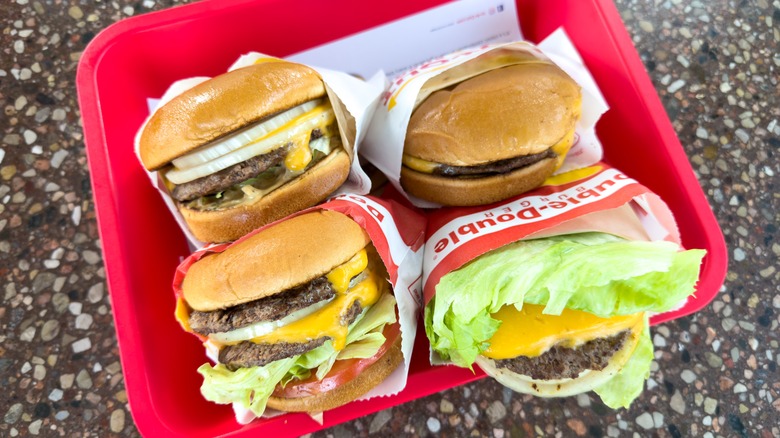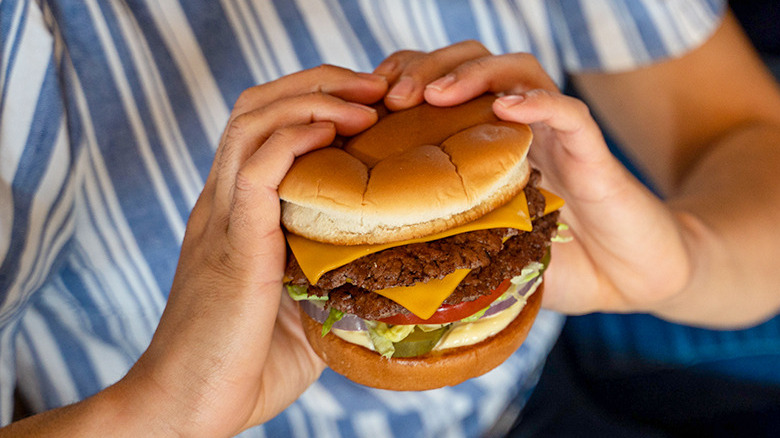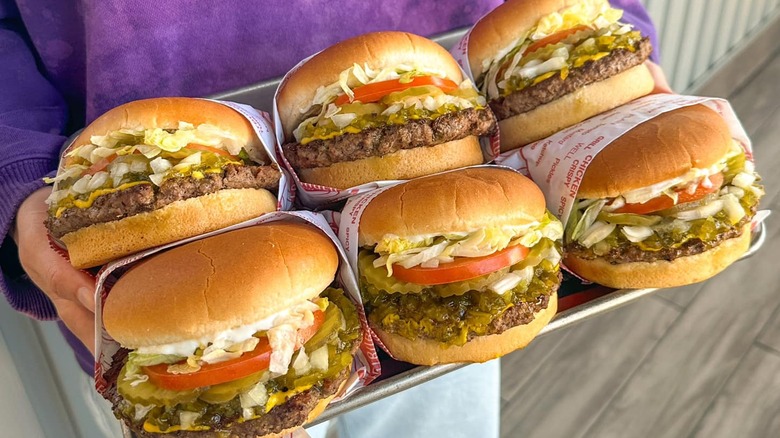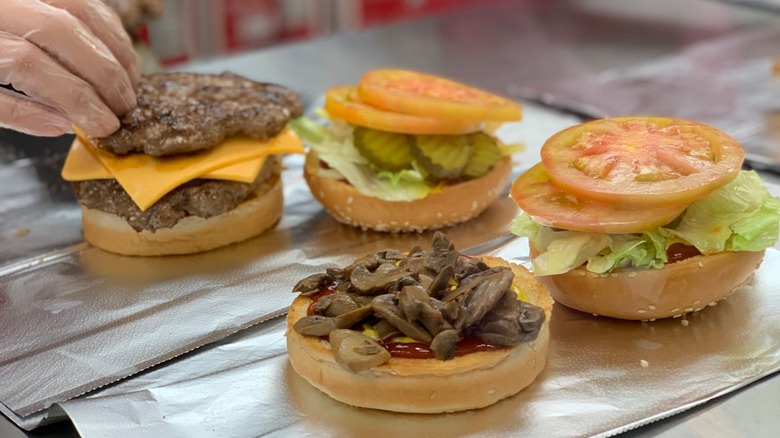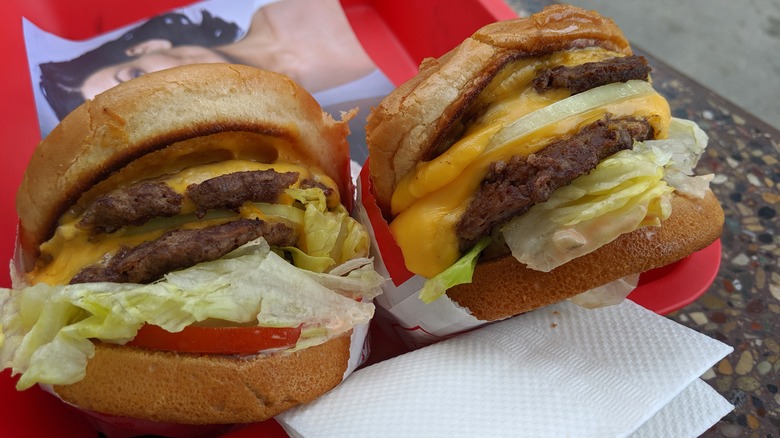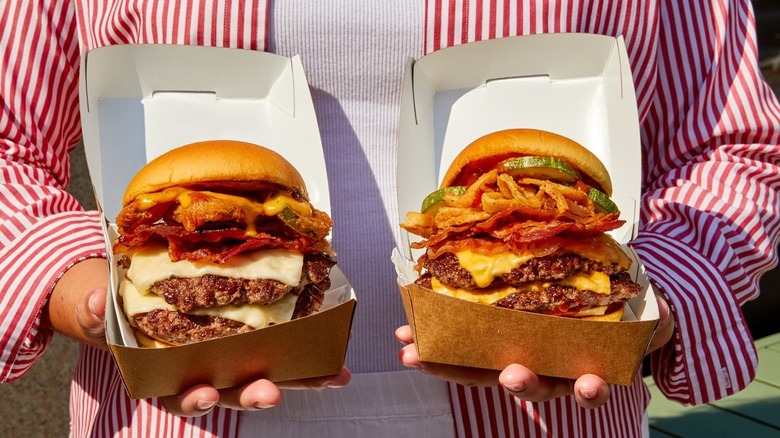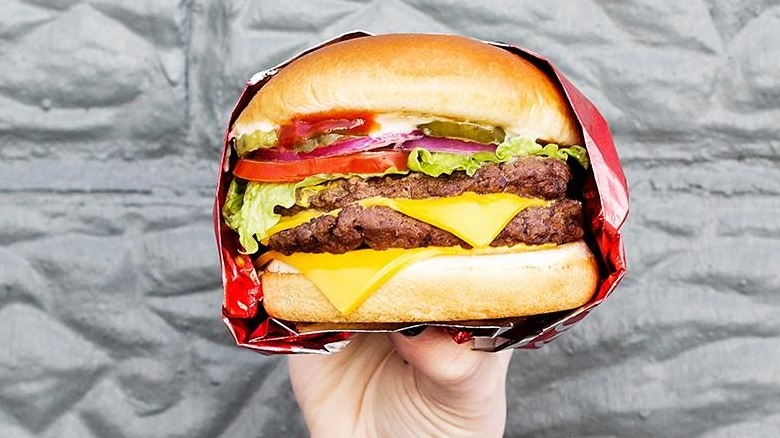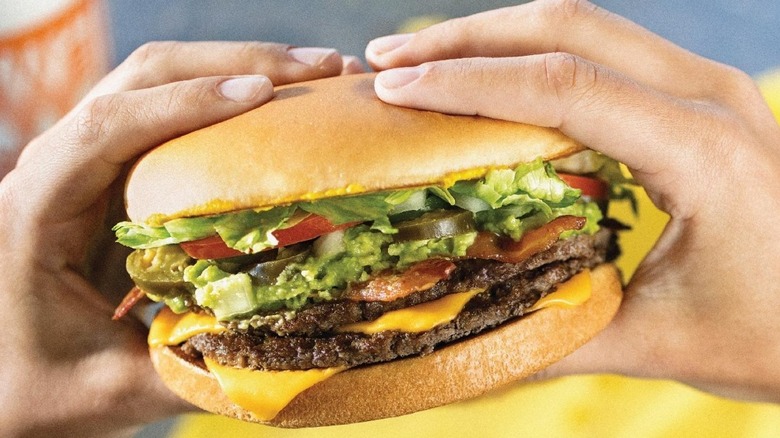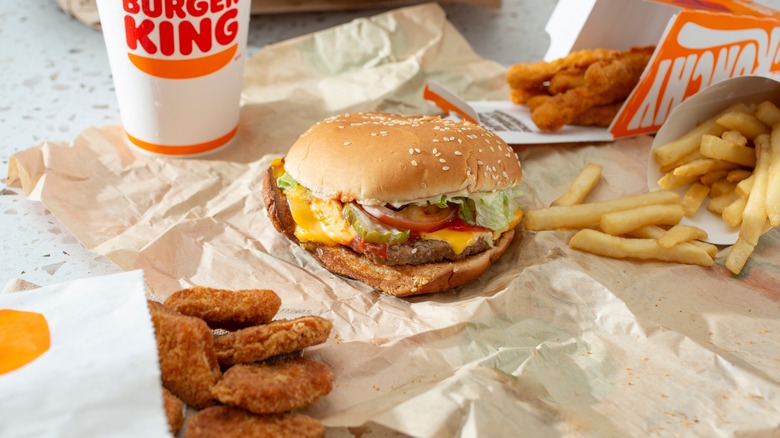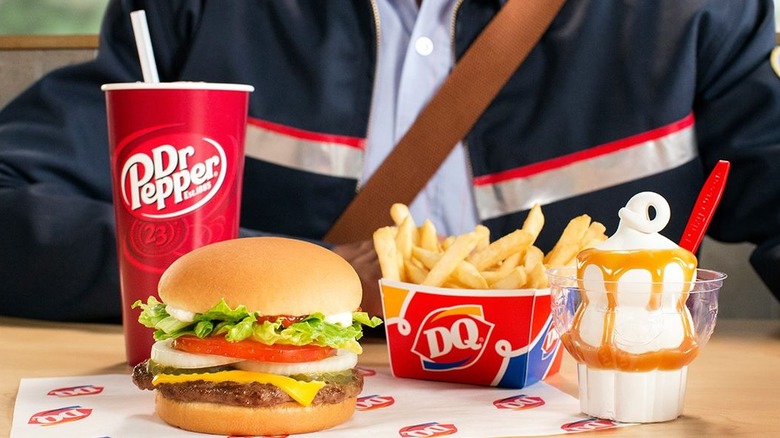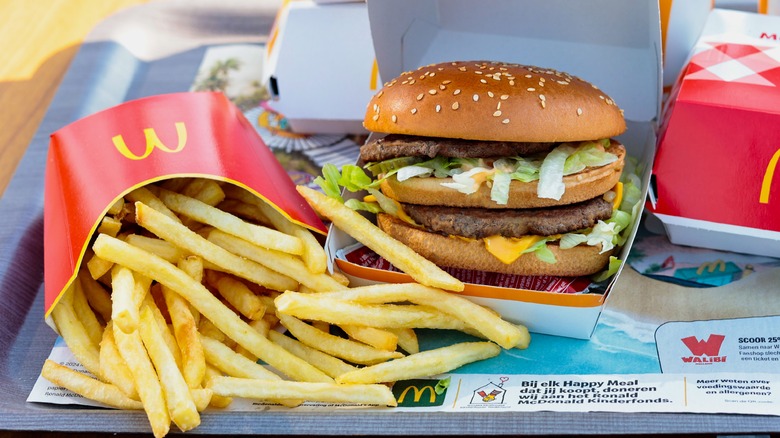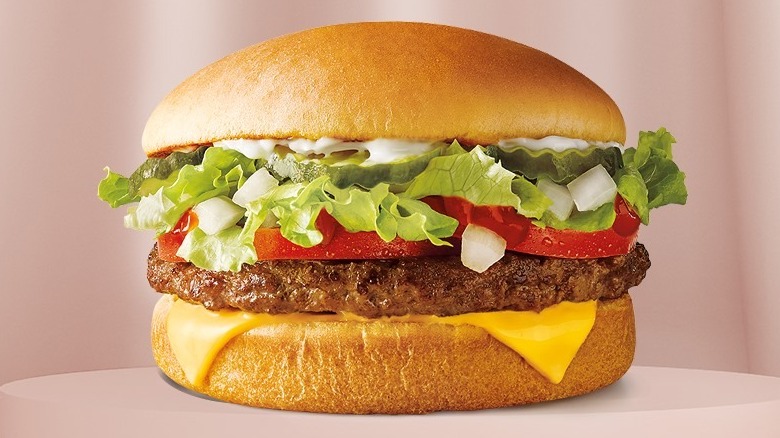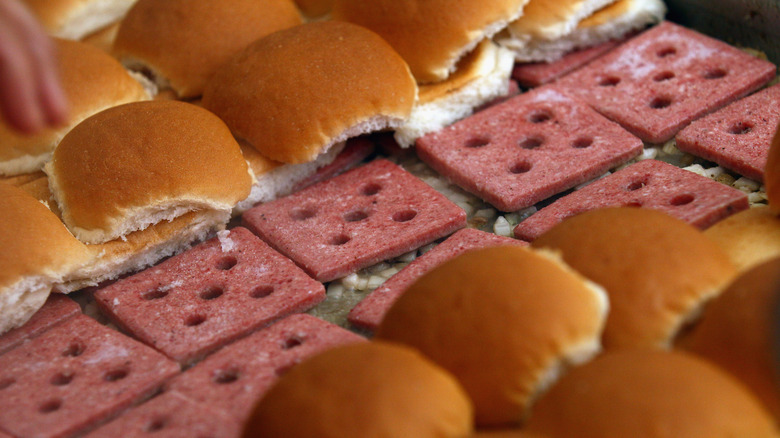7 Fast Food Chains That Never Use Frozen Burger Patties & 5 That Do
Burgers are the most popular American meals served in the United States. It's no wonder, since nearly every corner of the country has at least one burger chain nearby. Some of these burger joints are more local, with reaches isolated to a small portion of the country, while others are far more widespread. Though chains have similar enough menus, the preparation process is anything but the same from chain to chain. Some places use fresh, local ingredients, while others have ingredients shipped in. And, of course, ingredients vary. For example, there are restaurants that choose cheddar cheese, and some chains stick with American cheese. Then, there's the issue of the actual burger patty and the big question: Is it fresh or frozen meat?
It turns out many of the largest burger chains use frozen patties; smaller chains, on the other hand, lean toward fresh meat. If a chain uses fresh beef, it's nearly guaranteed that some form of marketing will be involved — in other words, these establishments proudly proclaim fresh beef. On the other hand — if there is little said about the meat — in all likelihood, frozen patties are used in the chain's burgers.
To research, we often resorted to watching staff prepare burgers on social media to determine the relative fresh or frozen nature of the patties. Starting out with all the chains that use fresh meat, we'll end on the ones that use frozen — which might be a deal breaker for some of you.
Fresh: Culver's
Though many come for the curds and custard at Culver's, the burgers — or Butterburgers — are a force in their own right. The Culver's burger menu includes pretty basic cheeseburgers and burgers with varying degrees of veggies. Outside of these more common burgers, you can choose a mushroom and Swiss or from a couple of melts. The one commonality between all of the options is that they all include "100% fresh, never frozen beef," according to the proudly displayed marketing on Culver's site. Here, burgers get the smashed treatment, creating crispy, flavorful bits on the edges of the burger patty. Like In-N-Out, Culver's is a little limited in location, but it does cover a pretty large swatch across the country.
About those curds — predictably, this chain hails from Wisconsin, where cheese curds are nearly a religion. You can also order rotating specialty custard flavors ranging from ultra chocolate to fruity. Chocolate and vanilla are always standby options, too.
Fresh: Fatburger
Once called Mr. Fatburger, this chain got its start in 1947 as a little stand. The chain dropped the honorific when founder Lovie Yancey split from her husband in 1952. For locations, your best bet to visit a Fatburger is in California, which far surpasses any other state for the number of locations, even though it doesn't get as much love as In-N-Out. At the time of writing, Los Angeles alone has 14 locations. Traveling internationally? There are also a small number of spots in Africa, Asia, and Europe.
Fatburger's burger range is very customizable, layering on the patties and add-ons. Starting with a medium burger, you'll get one grilled burger patty weighing in at a quarter pound of lean beef. The large size has a single patty as well, but it is a half a pound. Extra large adds an additional patty, and the extra, extra, extra large has a total of three patties. If you're keeping track, that's a pound and a half of burger meat. To dress up these burgers, you can ask for "The Works" for a full mess of shredded lettuce, sliced tomatoes, pickle chips, chopped onions, mayo, mustard, and relish. The finish is a toasted bun made of sponge-dough. With these layers of ingredients, this is one brand that lives up to its name.
Fresh: Five Guys
Walk into any Five Guys, and you're greeted with walls adorned with celebrations of the brand, free peanuts, and an open kitchen with a bustling grill. Your food is all made well within sight, so it's easy to watch those burgers go on the grill as fresh patties, be smashed to perfection, and then dressed to your heart's content. Five Guys doesn't just do fresh beef; everything here is fresh, never frozen. In fact, there aren't even freezers in the restaurants; you'll only find coolers here.
The once small, family owned business started by the Murrell brothers out of Arlington, Virginia, has grown to become something of a nationwide phenomenon, with almost every state (except Alaska) having at least one location. Washington, DC alone has seven.
The burger menu is pretty simple. To begin, you'll decide if you want cheese, bacon, and the number of patties. The little version has one, and the basic burger has two. Then, you can choose all the condiments you want. Whether you're in the mood for one big, sloppy burger that needs a fork or something simpler, Five Guys will make it how you want it. Whatever you do, don't forget the fries and milkshake — and, you know, thank us later.
Fresh: In-N-Out
We love a great burger stop origin story, and In-N-Out has a pretty good one. This California institution started as the first drive-through burger stand in 1948, just a few years following the conclusion of World War II. At this location, founder Harry Snyder served burgers prepared from meat and toppings collected at local markets. The drive-through concept wasn't the only innovation of convenience In-N-Out would introduce. You can also thank this chain for the ability to order without even leaving your car, thanks to Snyder's creation of a two-way speaker box.
One look at the menu, and it's clear that In-N-Out loves its burger patties. On the basic menu, you can order a typical one patty burger or cheeseburger, but then the patties get a little out of control from there. A double-double with double meat and cheese isn't too outrageous, and a 3X3 with triple patties isn't necessarily new, but a 4x4 with four patties is a little ridiculous. Both in appearance and eating logistics, we're left scratching our heads a bit. Not to mention, there's a version called "animal style." You might imagine this has something to do with a vegan burger patty, but it actually refers to a mustard grilled burger with extra spread, grilled onions, and pickle.
Fresh: Shake Shack
Shake Shack's beginnings go back to a hot dog cart raising money to beautify the city in the form of a public arts project. Though it didn't begin as a burger joint, Shake Shack's commitment to burger quality is clear.
Shake Shack has a rather hefty burger menu, but one of the pieces it emphasizes the most is the quality of its beef. These burgers utilize a "custom 100% Angus beef blend, never frozen, no hormones or antibiotics ever, humanely raised and grazed in the USA." The difference between other brands and the way Shake Shack talks about its beef is notable. For instance, most brands, if they mention beef at all, refer to the fact that it is fresh but not frozen. Shake Shack goes several steps further and mentions that the actual blend of the beef is custom, and then gets into the specifics on how the cows enjoy life. There are several promises here, but, of course, it's the never frozen aspect we're most interested.
Beyond that, the burgers themselves go anywhere from a classic Shack Burger, which is a regular beef cheeseburger with not too much notable about it, all the way to an avocado bacon burger, which is your typical cheeseburger with bacon and avocado in it. At the time of writing, there was also a smoky classic barbecue burger, which paired the beef patty with cheese, crispy onions like you would get on top of green bean casserole, and barbecue sauce.
Fresh: Wendy's
Many of the other burgers discussed here come from chains that are a little more on the smaller side. They feel more niche, boutique, and even elevated. These brands still might be fast food, but there's a certain uniqueness that makes them feel just a step above. Wendy's, on the other hand, feels more like a basic fast food restaurant. What does set Wendy's apart, however, is the fact that these burgers are, in fact fresh like a smaller chain rather than frozen like some of the bigger guys.
Another distinguishing part of the Wendy's burger is that it comes in a square patty rather a round one. This is a distinct difference even from many of the more elevated fast food places you see. The fact that these burgers hang off the side of the bun is sort of the point. The intent is that you see the burger's quality even before you take a bite.
These burgers don't have a whole lot of extravagance to them — the menu offers more simplistic options with single, double, or triple patties. Beyond that, you can add bacon to any of those levels to create a bacon cheeseburger rather than a simple burger.
Fresh: Whataburger
Though Whataburger has spread across the mostly southern part of the United States, Texas has a solid hold on the state with the most Whataburgers. In Texas alone, there are 739 locations. The next closest state is Florida with 45 locations.
Everything may be bigger in Texas, and Whataburger believes this as much as any Texan. In addition to taking great pride in the size of its burgers, Whataburger also uses 100% beef that is never frozen. Looking at the name, it may be a little unclear exactly how it should be pronounced, but it becomes much clearer when you realize that the founder Harmon Dobson intended it to be a mashed together version of "What a burger!" That is, it's an exclamation for what you might say with a burger that large. Its sandwiches are rather on the simple side, offering multiple patty options and then a couple with additions like jalapeño and cheddar or bacon and cheese.
Frozen: Burger King
Since Burger King proudly proclaims that its burgers come off of a flame grill, you're no doubt picturing a flaming grill the same way we are. Sorry to bust that narrative, but it's a little less intense than that. Admittedly, the process looks a little less appetizing with frozen burger patties passed into a covered flame grill that automatically does all of the work.
We've noticed that most restaurants do not advertise when they use frozen meat, and Burger King is no different. Instead, to discover the precise way these burgers are grilled, we resort to platforms like TikTok where users like to show the process behind the scenes of at least some locations.
The frozen patties help ensure that Burger King's Whoppers are the same every time you order one, regardless of which location you're stepping into. This consistency for large chains like Burger King is one of the appetizing factors for many. And while the prospect of frozen meat may not be the most luxurious, for some, the consistency of a Whopper is worth the swap to frozen meat.
Frozen: Dairy Queen
Growing up, the Dilly bar was the king of cold treats. And there's only one place you can get a Dilly Bar: Dairy Queen. Getting dinner during an ice cream visit was one of the restaurant's great draws. What better way to get a kid to eat their meal than take them to their favorite ice cream shop, after all?
Dairy Queen, like other chain fast food restaurants speckling the vast majority of the country, relies on frozen burgers, too. However, these burgers aren't round or square. Instead, they're cut and frozen in wavy circular shapes. This way, the waviness of the burger mimics a handmade patty when cooked. Obviously, this type of information wouldn't be prominently advertised, but with a little social media sleuthing, we found that the Dairy Queen of Homestead was sharing how its double bacon cheeseburger was made. In the process, you can clearly see that Dairy Queen's burgers burgers are not circular but more wiggly around the edges.
Frozen: McDonald's
When you think of fast food, there's a good chance that perhaps the number one restaurant that comes to mind is McDonald's. Not surprisingly, McDonald's uses frozen patties for its burgers. What may be surprising, however, is how honest McDonald's is about it. While most restaurants dedicate no portion of the company website sharing information about frozen burger patties, McDonald's is up front about it and explains that its burgers are 100% ground beef that gets frozen at the supplier which, as McDonald's says, "seal[s] in great fresh flavor."
McDonald's is diligent about how it creates recipes and has a process for making sandwiches in a way that is hard for other brands to replicate. Everything from the seasoning application down to the specific types of condiment dispensaries workers use is regulated. In this way, McDonald's can ensure that burgers created anywhere in the country, following the same standards, will create the same flavor. The frozen meat is an important part of this equation because the shape, size, and mixture of meat can be closely controlled. This ensures that no single employee is creating a burger different than any other employee across the country.
Frozen: Sonic
Tracing its roots back to a restaurant called Top Hat Drive-In, Troy Smith opened the business that would become Sonic in 1959. The drive-in concept in those early days never went away, and while it's hard to find a place that reminds us of a bygone era, a drive-in can certainly do it. But, if you're like us, you may wonder if those burger patties are fresh enough. We can thank this Tiktok creator for the answer to that question. In his videos, Mr. Sonic pretends to be something of a Sonic robot, making items people request. Through these videos, we learn that Sonic burger patties go straight from the freezer to the griddle.
Sonic's burger menu goes from the most basic of cheeseburgers with just a plain cheeseburger and a burger, bun, to the involved garlic butter bacon cheeseburger. No matter what type of burger you choose, be sure to grab some tots and drink to round out your meal.
Frozen: White Castle
The distinction for the very first fast food burger chain goes to White Castle, home of the slider and burger joint that looks like, well, a white castle. The legacy began in 1921 with sandwiches that were simple and easy to eat. Those burgers are still beloved today, and they're cooked much differently than many other fast food burgers.
The first step of these sliders is a layer of onions on a large griddle. Then, those cooking onions get a layer of frozen solid square burgers with holes in them. The holes are there so that the burgers can cook through a steaming process, and the bun can warm that way, too. The meat is frozen to help the steaming and layering processes. Without the frozen burgers, layering would be much more challenging. For White Castle, frozen burgers are used for convenience, consistency, and logistics — and the small buns are perfectly sized for the burgers. After the burgers and their layer of onions leave the griddle, they get cheese and finishing dressings.
